It’s the last week to catch Open Eye Gallery’s LOOK Climate Lab 2024, featuring new work in progress from Mishka Henner, artist-in-residence with Energy House 2.0.
Team Assistant, Sam Parker, attended the LOOK launch event back in January, and here he shares his thoughts on a few of his favourite works from the exhibition in Liverpool.
1. Executive Decision by Mishka Henner
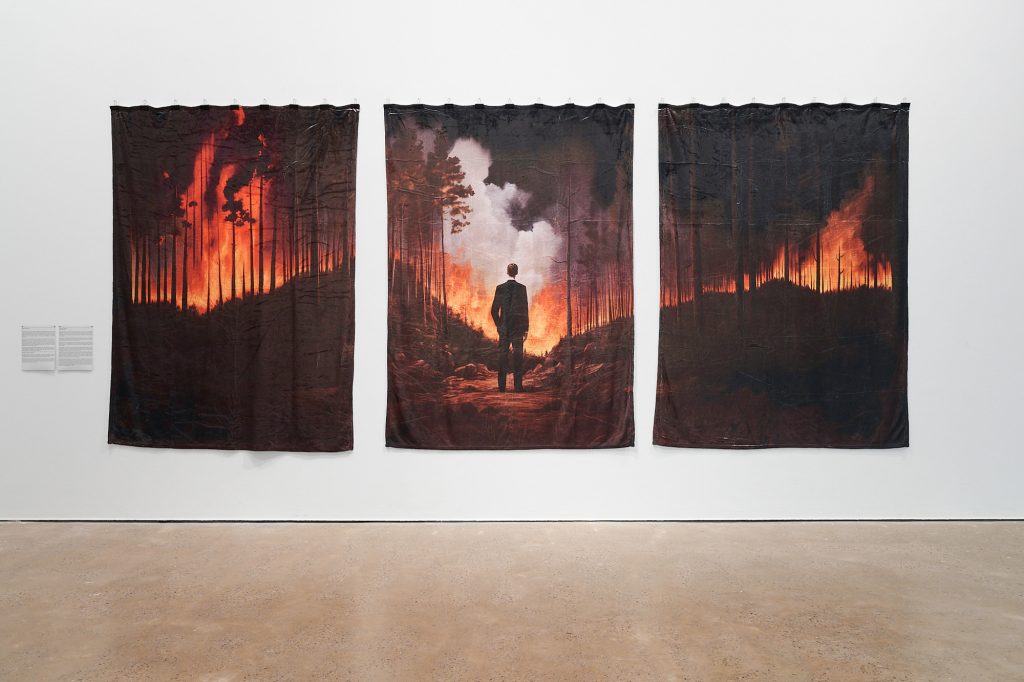
Sam Parker: To start with, I can’t not mention Mishka Henner’s new work Executive Decision. One of our current artists-in-residence at Energy House 2.0, Henner has begun to develop work with the AI Midjourney, creating his own worlds and imagery using prompts that continuously manipulate the work.
The layers of the work really draw me in. The work itself depicts a man in a business suit, not panicked by the prospect of fire, but to me, he seems content or even relaxed. Combined with the title of the work, Executive Decision, it makes me think of the government and organisational decisions that continue to do our planet harm; an ‘executive decision’ to damage the already depleting health of the environment around us.
I’m also really interested in Henner’s use of artificial intelligence, particularly at this time when conversations about AI are so contentious. The painterly aesthetic of the piece seems to point towards the way AI may make traditional labour techniques redundant. From a distance, and with no knowledge of Henner’s work, you’d be forgiven for thinking it was a painting – drawing inspiration and source material from historical artwork when discussing the work with Henner ahead of the exhibition, he rightly said it could be “indistinguishable from paintings.”
Along with this, Henner has deliberately used a service that prints on demand for this work – highlighting another problem that we as a society are facing; the mass production of goods with no care for the environmental impact of said production. The work speaks to the nature of modern culture; we can make and sell anything, without care for the process and impact of its production.
To me, these things combine to make a truly thought-provoking work, which describes contemporary problems, the diminishing viability of hand-crafted products, and the almost glorification of destruction that we as a species cause.
2. Strange Eden by Mario Popham
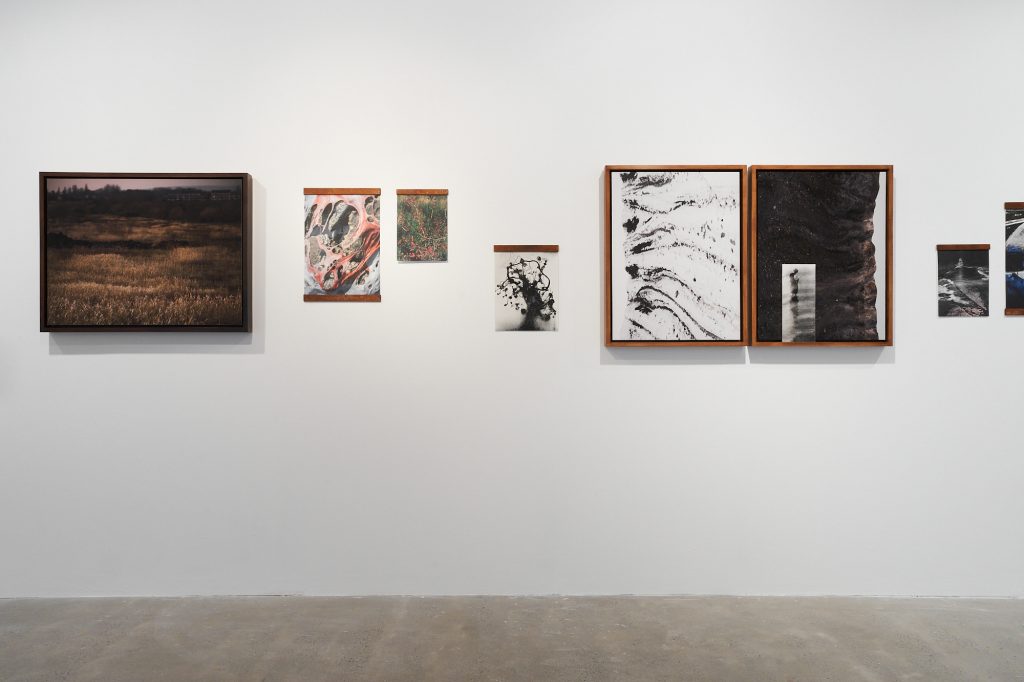
I really enjoyed the variety of Mario Popham’s work on display here; the striking photographs, and also the experimental methods employed in a couple of the more abstract pieces. Particularly the layered pieces that literally stick out from the surface, giving an impasto aesthetic as the deep black colour prickles out from the imagery. This experimental approach interests me as someone who both photographs and paints. The material composition of the piece is also apt, using coal and other materials from the Brickershaw Country Park; which used to be a coal mine. This adds depth and connection to the source of Popham’s work.
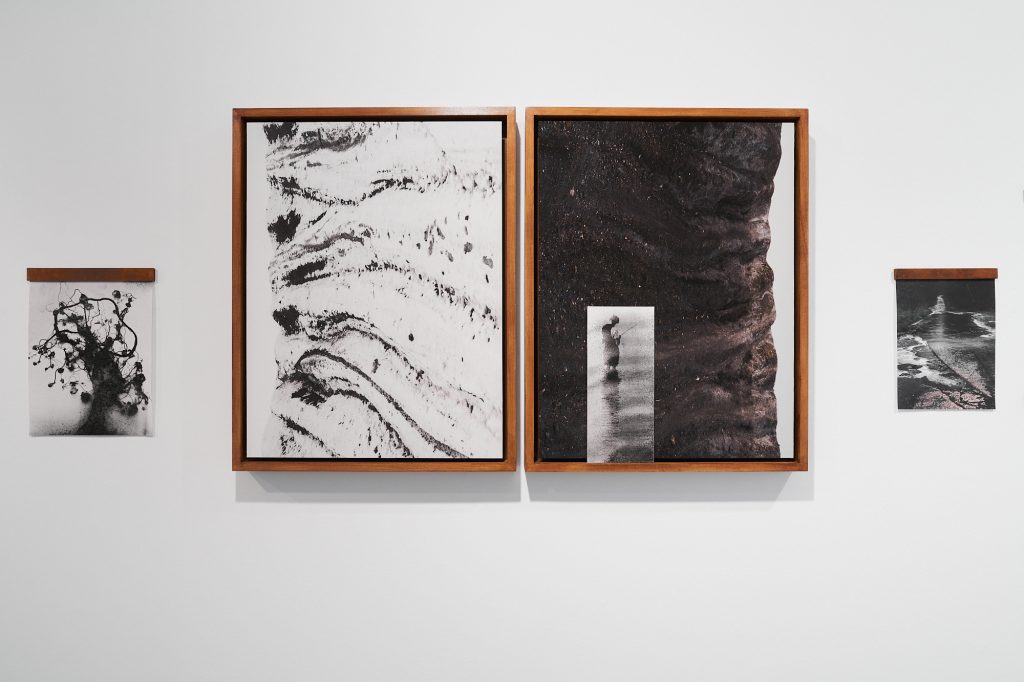
There is something otherworldly about Popham’s work – in terms of shape and form, some of the works are almost reminiscent of the aliens and their language from the film Arrival – ink-like forms suspended in the air, travelling within something akin to a circulatory system.
3. Co-Creation with the Environment by Lizzie King
Details from Lizzie King’s Co-Creation with the Environment series. Courtesy of the artist.
Alongside Popham’s work, current MA Contemporary Art student and previous Graduate Scholar with the Collection Lizzie King also presented some beautiful experimental pieces that use nature itself to create the works on photographic paper. These works also provide this cosmic feeling and aesthetic; looking to contain special formations of stars, gases, and other astral bodies.
Scuffs and scratches, dirt and debris – King uses the unpredictability of nature to further enhance the works itself, using sustainable processes the work combines analogue processes and nature into one complete package.
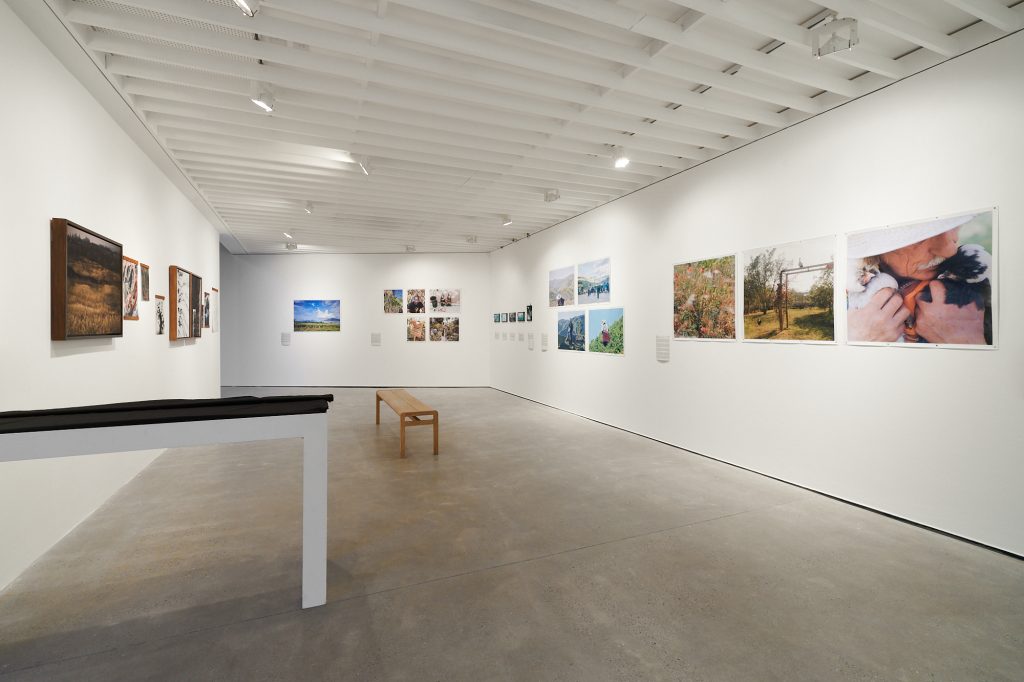
From what I understand the prints are not fixed, and so are still altered by light – In Open Eye Gallery they are covered with a cloth that has to be lifted to view the work. I find the prospects of this quite interesting, as over time, the prints will change with each viewing until eventually, the print has become overexposed; along with the materials that have been kept on the surface, this could produce wildly varying results allowing all to ponder which element created certain colours and forms– it’s exciting!
4. Kherson by Nazar Furyk
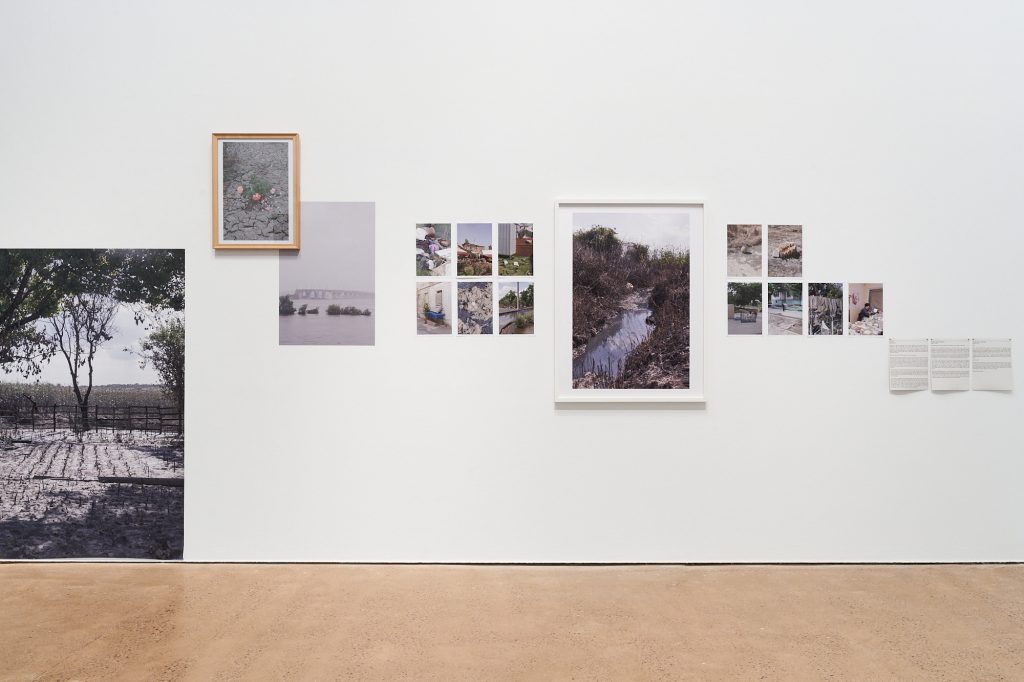
I also wanted to discuss Nazar Furyk‘s series of photographs taken within the Kherson region in Ukraine. Given the contemporary nature and global political situation surrounding the war in Ukraine, Furyk explores the ramifications of the conflict; not just the military action, but the people who continue to live through this, how it affects them, and how the war ultimately affects them as individuals.
Furyk shows us rubble, rubbish, murky waters, claustrophobic offices, books in the open, an abandoned football, destroyed infrastructure, and the resulting contaminated area from the destruction of fuel and chemicals – which then made its way into the Black Sea. Furyk visited this region several times, including immediately after the destruction of the Kakhovka Hydroelectric Power Plant dam. A sustainable energy source destroyed – this begs the question: how will they recover? With so much lost, and the war not even over yet, how will they rebuild? Will the damage done to the environment ever be rectifiable?
It was interesting to compare this work to Stephanie Wynne’s Erosion work, where she explores the structural waste as a result of war and how post-WWII era Liverpool had to deal with the waste from bombed homes. In this case, tonnes of rubble from the bombed homes were dumped on a mile-long stretch of coastline – will something similar be the fate of Ukraine’s post-war waste?
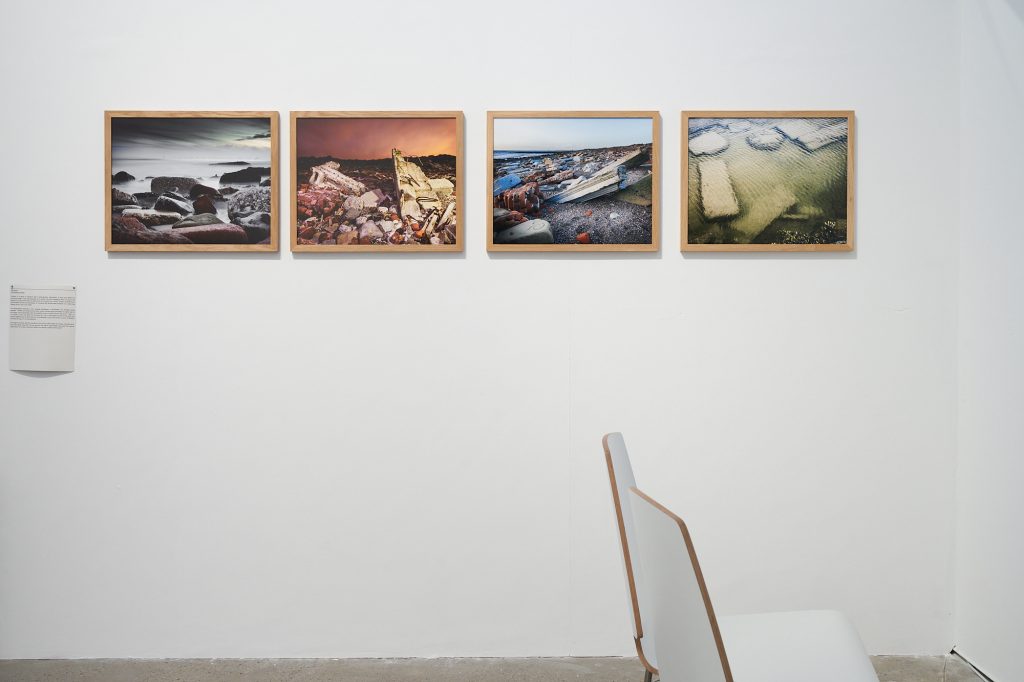
There is one image that Furyk has captured that stood out from the rest for me; taken after the dam’s destruction, arid cracked ground, debris, and a sense of barrenness – green leaves rise from between the cracks, flowers bloom and shed their petals amidst the chaos. Life finds a way, and life goes on.
LOOK Climate Lab 2024
There’s still a week left to catch LOOK Climate Lab 2024 at Open Eye Gallery Liverpool. The exhibition closes on the 31st of March.
LOOK Climate Lab is a biennial programme exploring how photography can be a relevant and powerful medium for talking about climate change. The programme sees the gallery transformed into a lab: bringing together researchers and artists to test their ideas and encouraging our audiences to discuss systematic changes needed for dealing with the climate crisis.
Find out more about LOOK Climate Lab and visiting Open Eye Gallery over on their website, here.
Energy House 2.0 Artist-in-Residency Programme
In partnership with Open Eye Gallery, Liverpool and Castlefield Gallery, Manchester, the University of Salford Art Collection is currently hosting two artist residencies at Energy House 2.0, the unique, world-leading energy performance facility at the University. Mishka Henner was awarded the first of two 18-month artist residencies in early 2023. Emily Speed was awarded the second residency in summer 2023. Both artists are developing new work in response to Energy House 2.0’s research, exploring themes of the climate crisis, net zero research, and the future of housing. Find out more about our residencies here.
Sam Parker
Graduating from BA(Hons) Fine Art at the University of Salford in 2023, Sam joined the Art Collection team as a graduate associate in October of that year, working closely with the team to develop collections care, technical installation, and his own curatorial skills.
Sam is continuing to explore all avenues of knowledge in the curatorial world whilst aiding in exhibition installations, artist development, networking, planning, and the inner workings of the Art Collection.
He also maintains a fine art practice with an interest in sound, music, and synesthesia – how audio and visual mediums can come together to create enhanced experiences. Find out more about Sam’s fine art practice here.